The Intel Xeon Silver 4112 is one of the more intriguing parts. It is a low core count Intel Xeon Silver which means it is one of only three quad core, eight thread CPUs in the launch Intel Xeon Scalable processor lineup. Unlike the Intel Xeon Gold 5122 it does not have high clock speeds. What it does carry is 2.0625 MB L3 cache per core in addition to the 1MB per core L2 cache. Price wise, this chip retails for just under $475 putting it between the Silver 4108 ($410) and Silver 4110 ($500) which are 8 core, 16 thread chips in this generation.
Key stats for the Intel Xeon Silver 4112: 4 cores / 8 threads, 2.6GHz base and 3.0GHz turbo with 8.25MB L3 cache. The CPU features a 85W TDP. Here is the ARK page with the feature set.
Test Configuration
Here is our basic test configuration for single socket Xeon Scalable systems:
- Motherboard: Supermicro X11SPH-nCTF
- CPU: Intel Xeon Silver 4112
- RAM: 6x 16GB DDR4-2400 RDIMMs (Micron)
- SSD: Intel DC S3710 400GB
- SATADOM: Supermicro 32GB SATADOM
One of the key advantages the Intel Xeon Silver series has is the ability to use up to 12 DIMMs per socket. Intel’s embedded platforms and quad core Intel Xeon E3-1200 V6 series platforms cannot do this in 2017. DDR4-2400 is the fastest memory supported on the Xeon Silver platform which is why we are not using faster speeds.
Here is the lscpu output of the chip:
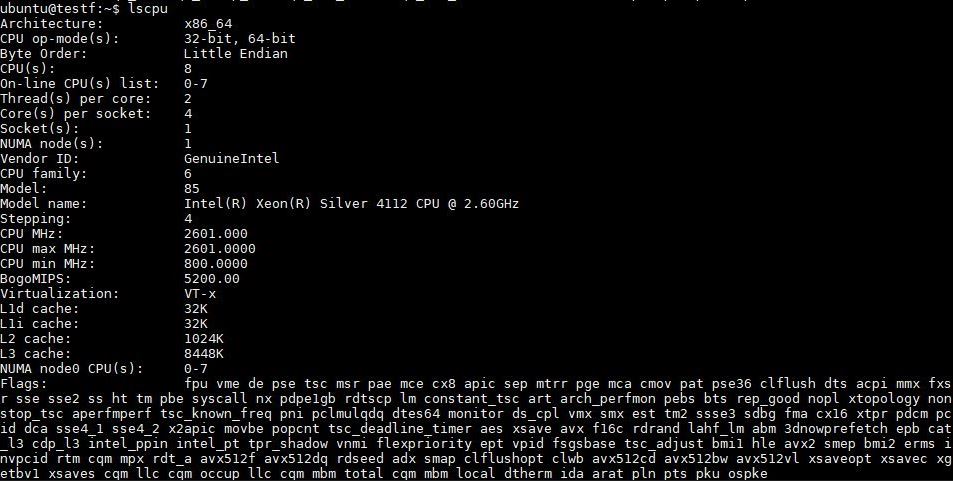
Single Intel Xeon Silver 4112 Benchmarks
For this exercise, we are using our legacy Linux-Bench scripts which help us see cross platform “least common denominator” results. We do have a full set of expanded benchmarks from our next-gen test suite (Linux-Bench2) so expect to see those results sprinkled in as we get a larger comparison data set built. These results have also been previewed elsewhere, such as the Intel Atom C3955 benchmarks we did so you can see larger data sets in our other reviews. Here we are going to focus on generational performance.
Python Linux 4.4.2 Kernel Compile Benchmark
This is one of the most requested benchmarks for STH over the past few years. The task was simple, we have a standard configuration file, the Linux 4.4.2 kernel from kernel.org, and make the standard auto-generated configuration utilizing every thread in the system. We are expressing results in terms of compiles per hour to make the results easier to read.
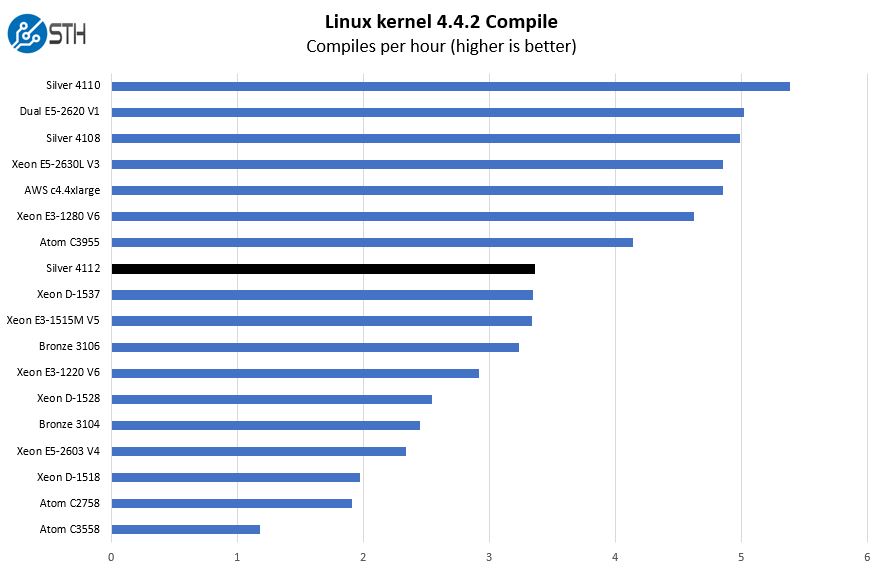
Higher clock speeds, more memory bandwidth, and larger caches let the Intel Xeon Silver 4112 keep up with a higher clocked Intel Xeon E3-1515M V5 CPU and eight core Xeon D. At the same time, one only needs to look at the Intel Xeon Silver 4108 to see that in a highly-threaded workload going down the SKU stack to the lower cost Intel Xeon Silver 4108 makes sense.
c-ray 1.1 Performance
We have been using c-ray for our performance testing for years now. It is a ray tracing benchmark that is extremely popular to show differences in processors under multi-threaded workloads.
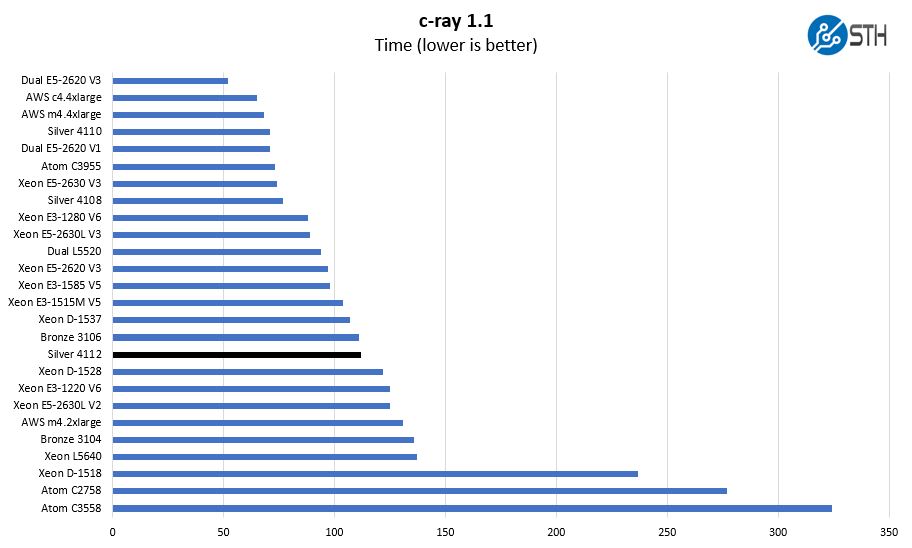
This is the first chart where we are going to see an interesting pattern. In some narrow situations, the eight core Intel Xeon Bronze 3106 by having twice the number of physical cores overcomes a lack of Hyper-Threading and a lower core speed to match the Intel Xeon Silver 4112 that costs almost twice as much.
7-zip Compression Performance
7-zip is a widely used compression/ decompression program that works cross platform. We started using the program during our early days with Windows testing. It is now part of Linux-Bench.
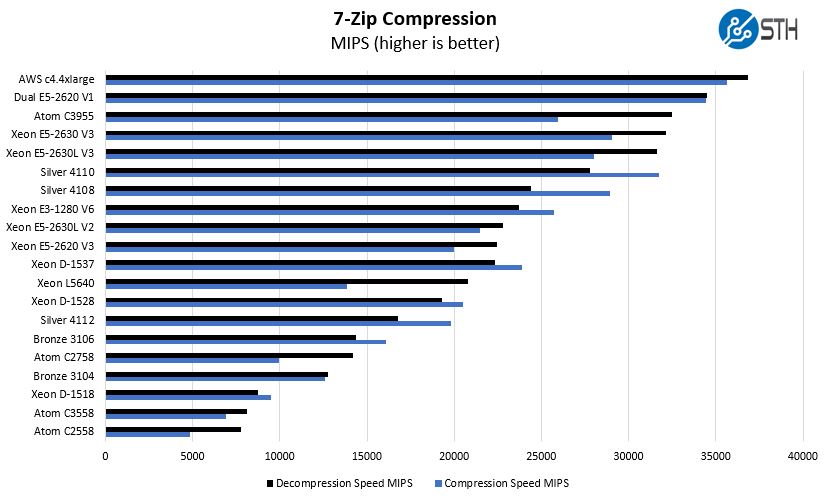
7-Zip benefits from having additional cores and threads. Here we can see the higher Intel Xeon E3-1200 V6 clock speeds or the higher core count Xeon Silver chips do well.
NAMD Performance
NAMD is a molecular modeling benchmark developed by the Theoretical and Computational Biophysics Group in the Beckman Institute for Advanced Science and Technology at the University of Illinois at Urbana-Champaign. More information on the benchmark can be found here. We are going to augment this with GROMACS in the next-generation Linux-Bench in the near future. With GROMACS we have been working hard to support Intel’s Skylake AVX-512 and AVX2 supporting AMD Zen architecture. Here are the comparison results for the legacy data set:
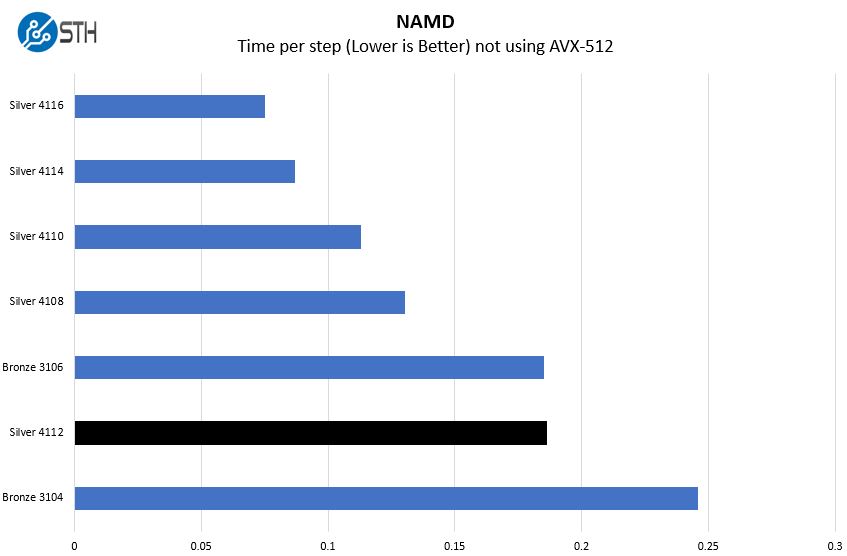
Here we wanted to again show what the simple lack of cores is doing to performance on multi-threaded workloads. If you are running NAMD, we suggest getting more cores.
Sysbench CPU test
Sysbench is another one of those widely used Linux benchmarks. We specifically are using the CPU test, not the OLTP test that we use for some storage testing.
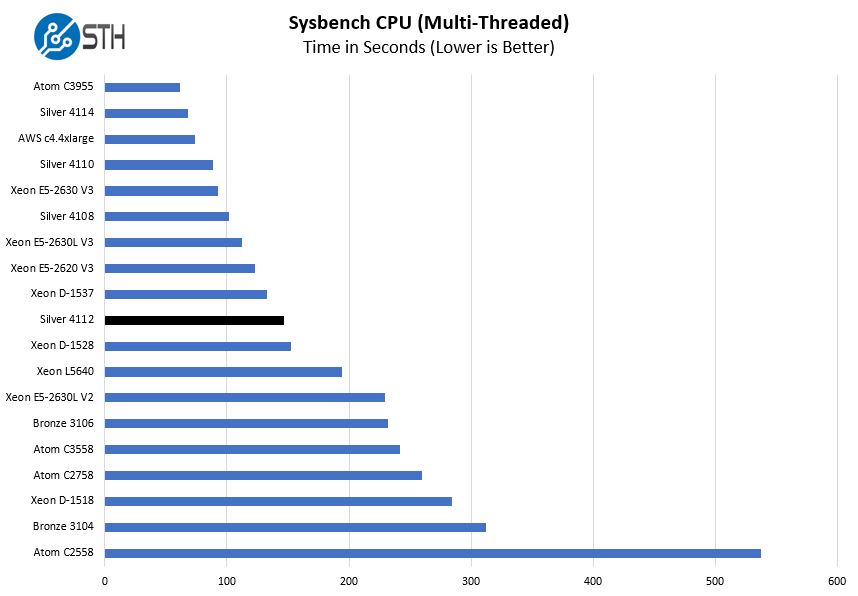
In terms of raw CPU performance, the multi-threaded Sysbench CPU loves having more cores. Higher IPC and clock speeds put the four core model in the range of a theoretical seven core Xeon D.
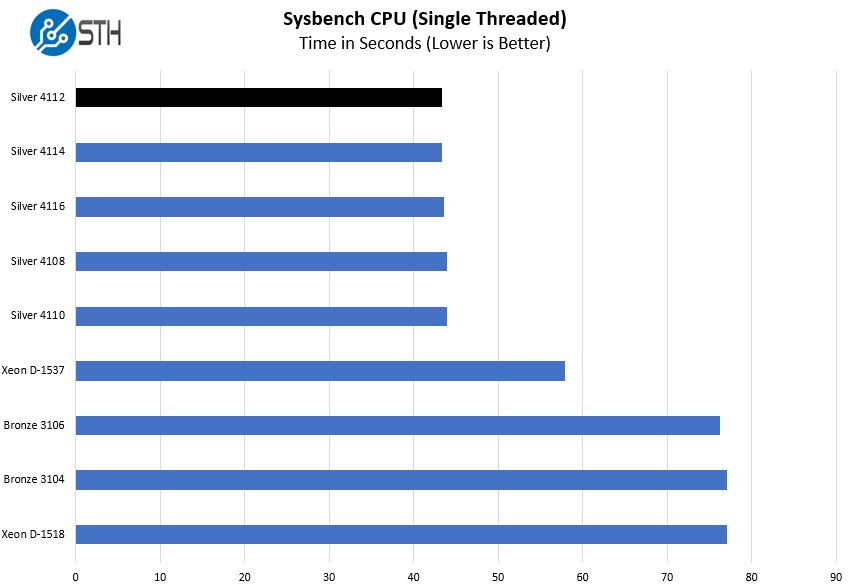
Since many will be thinking that single-threaded performance is where the Intel Xeon Silver 4112 shines, this is an awesome chart. When we sorted the Intel Xeon Silver results we can see the impact of a 3.0GHz max turbo frequency across the Xeon Silver range. Likewise, we can see the 1.7GHz cap on the Xeon Bronze range.
OpenSSL Performance
OpenSSL is widely used to secure communications between servers. This is an important protocol in many server stacks. We first look at our sign tests:
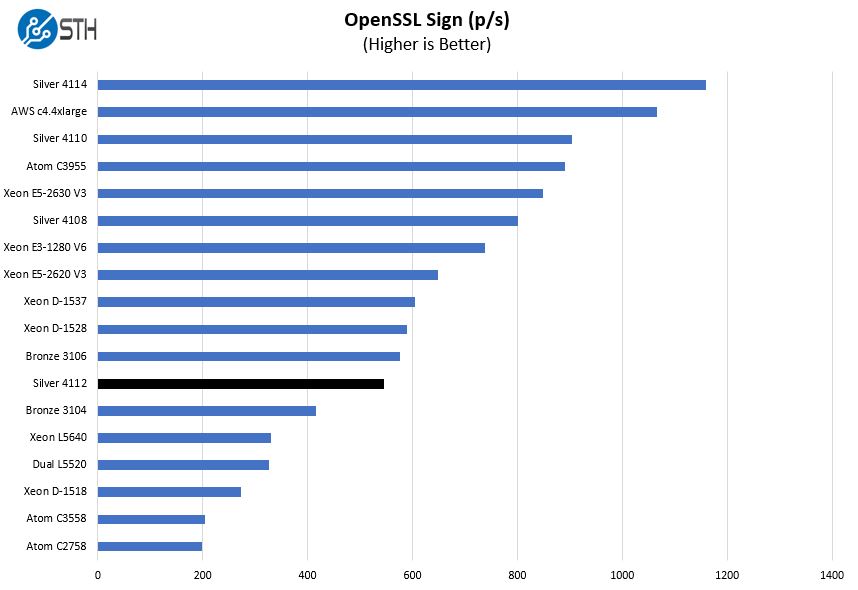
Here are the verify results:
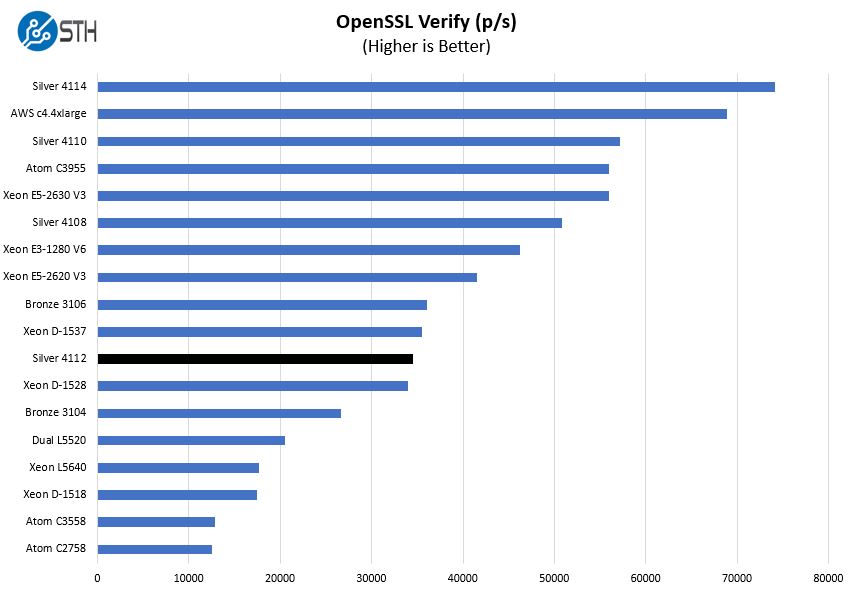
Again we have performance of about 75% more Xeon D cores. Although the TDP figures are different, if you want Xeon D performance trading a larger platform for slightly more power consumption (see our power consumption note below) the Intel Xeon Silver 4112 is extremely competitive when paired with the C622 PCH.
UnixBench Dhrystone 2 and Whetstone Benchmarks
One longest-running tests is the venerable UnixBench 5.1.3 Dhrystone 2 and Whetstone results. They are certainly aging, however, we constantly get requests for them, and many angry notes when we leave them out. UnixBench is widely used so we are including it in this data set. Here are the Dhrystone 2 results:
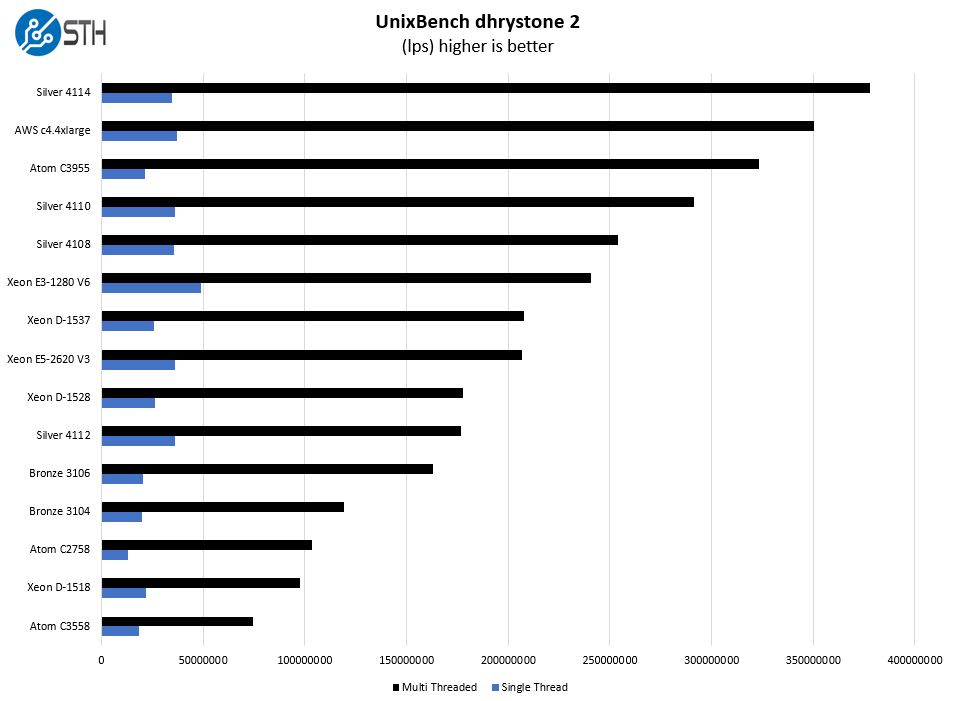
Here are the whetstone results:
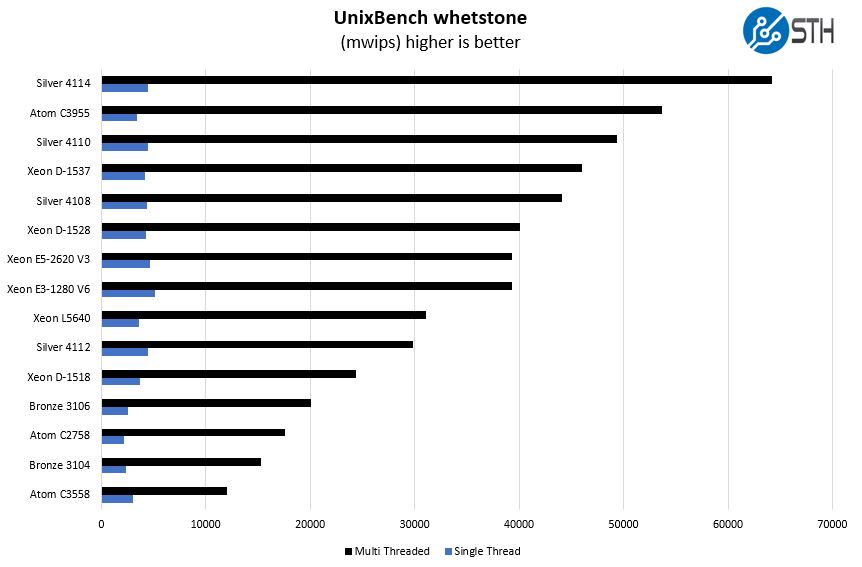
Again, we can see that if you want single-thread performance, the Intel Xeon E3-1200 V6 line is a better bet in the quad core world. At the same time, for multi-threaded workloads getting the Intel Xeon Silver 4108 is a better bet. The chart is sorted by multi-threaded results however we again see a tight band constraining all of the Intel Xeon Silver range.
GROMACS 57K Atom AVX2/ AVX-512 Enabled
We have a small GROMACS 57K Atom simulation we previewed in the first AMD EPYC 7601 Linux benchmarks piece. In Linux-Bench2 we are using an updated set that scales to 4-socket configurations with enough Atoms to fill all cores. For now, we do have a small dataset with the original work which remains valid, albeit we are going to transition to a larger set soon. This test will use the AVX-512 and AVX2 extensions if available.
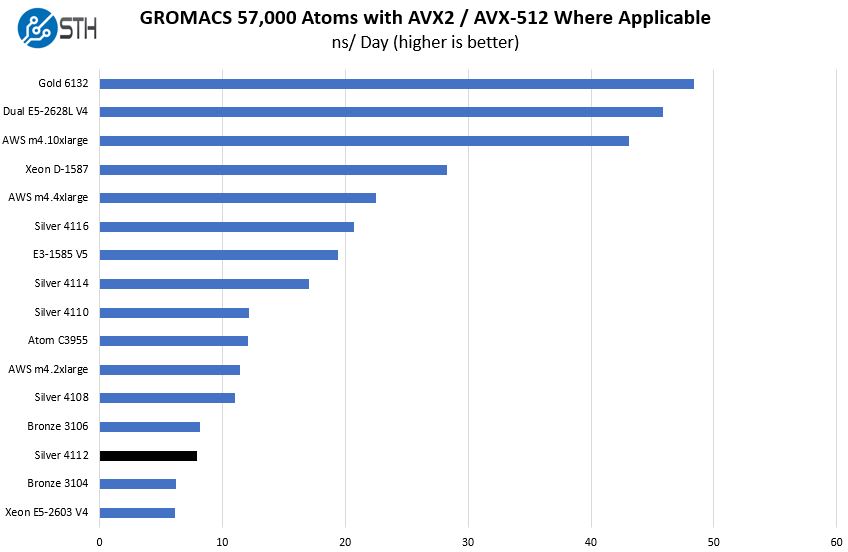
AVX-512 pushes the clock speeds of these parts down considerably. The Intel Xeon Silver 4112 base AVX-512 frequency is 1.1GHz while the 4-core turbo maximum frequency is 1.4GHz. The Xeon Bronze 3106 and Bronze 3104 have base and maximum AVX-512 frequencies of 0.8GHz which is how we are seeing the Bronze 3106 edge out the four core Silver 4112 here.
A Note on Power Consumption
We normally only publish power consumption data on full systems we review. There are too many variables for this data to land in a CPU test. At the same time, we wanted to highlight the Intel Xeon Silver 4112 which hit a maximum of around 86W measured at the outlet in our testing. While it may be an 85W TDP part, with 10Gbase-T links active, a SAS 3008 12gbps controller and a number of drives / DIMMs in the system, the TDP rating is significantly higher than actual power consumption. This chip borders on Intel Xeon D territory and below Intel Xeon E3-1200 V6 even with more memory installed.
Market Positioning
Here is the question you may be asking yourself after seeing the numbers: why does this part exist? It is a hard one to answer. From the perspective of single-thread performance, both the Intel Xeon Silver 4108 and Xeon Silver 4110 can match the 3.0GHz Turbo frequency. Both of those options also have twice as many cores and threads available with more L3 cache.
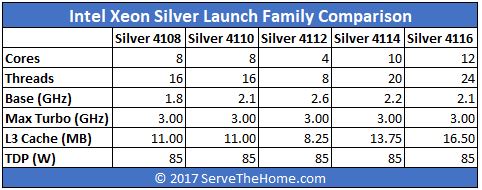
One common reason to have the lower core count CPUs is to minimize license expenditure. If license costs are significant, one would likely opt for an Intel Xeon Gold 5122 instead with a 3.6GHz base clock and twice the L3 cache at around $1200.
Unlike the Intel Xeon E3-1200 V6 series and the Intel Xeon D-1500 series, you do get a number of features with the Intel Xeon Silver 4112. There are 48 PCIe 3.0 lanes, six channel memory support for up to 768GB per socket. You can also get 100Gbps QAT in a Lewisburg PCH and the Xeon Scalable chips support dual socket configurations.
With the introduction of the Intel Xeon W series the single socket market positioning of the Silver 4112 chip is severely challenged. The Intel Xeon W-2125 at $444 supports only quad channel memory but has a 4.0GHz base and 4.5GHz turbo clock. The Intel Xeon W-2123 is only $294 with 3.6GHz base and 3.9GHz turbo clocks. If you want single socket Xeon Scalable and do not need six DIMM channels, you are now better off with those chips. Both of the Intel Xeon W parts support dual 512-bit FMA as a kicker.
If we were to describe the Intel Xeon Silver 4112 market positioning, it is:
- Single socket: Servers that need hex channel memory, will not use AVX-512, are core constrained due to licensing but not to the point where the Xeon Gold 5122 is better.
- Dual socket: Servers that are licensing constrained but need dual socket for PCIe or additional RAM and value power efficiency over the performance of the Gold 5122 which is $700 more each.
If you previously used the Intel Xeon E5-2623 V4 the Intel Xeon Silver 4112 should be roughly the same price (within 10%) and offer roughly similar performance (within 5% based on our estimates.) Perhaps the best way to describe this chip’s market is as the Intel Xeon Scalable evolutionary path for the Intel Xeon E5-2623 V4.
Final Words
Overall, this chip performed well enough and exactly how we expected. At the same time, the market segmentation for this part is extremely narrow and we would have preferred if it had a lower model number. The Intel Xeon Silver 4110 is a similarly priced CPU with twice as many cores and the same max turbo frequency. The Intel Xeon Silver 4114 has 10 cores. In most multi threaded workloads the Intel Xeon Silver stack goes
4112 -> 4108 -> 4110 -> 4114 -> 4116
And that is slightly strange since the 4112 does not have significantly higher clock speeds. On the other hand, if you were thinking about an Intel Xeon E3-1200 V6 system or a Xeon D system, the Intel Xeon Silver 4112 is priced attractively and lets one utilize a full Xeon Scalable system. It also sips power to a degree that its 85W TDP would not suggest.
If you want to know more about the Intel Xeon Scalable CPUs head over to our Intel Xeon Scalable Processor Family (Skylake-SP) Launch Coverage Central for in-depth information.

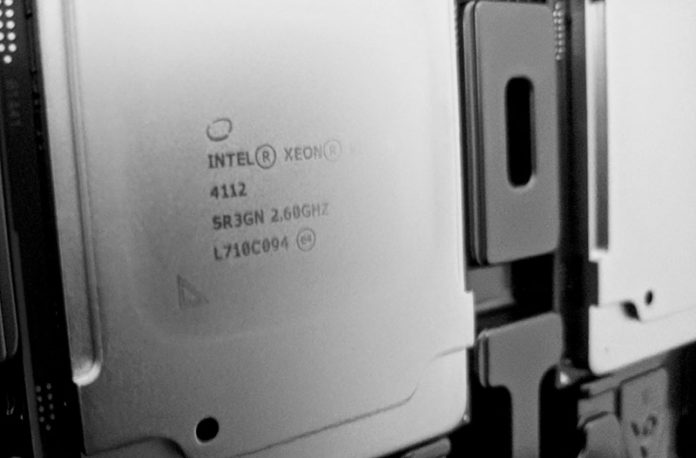



@Patrick
“We have a small GROMACS 57K Atom simulation we previewed in the first AMD EPYC 7601 Linux benchmarks piece. In Linux-Bench2 we are using an updated set that scales to 4-socket configurations with enough Atoms to fill all cores”.
A few GPU’s would also be nice, or are all those so called HPC unit only used to play games.
A 4 socket server with 4 X $10.000 CPU’s is nice, but when a 1 socket server with 6 GPU’s is only 1 x $10.000 this might be the better choice (or whatever mix is best).
When will EPYC be commercially available? It’s very quiet from the AMD side.
Working on the GPU side. On the EPYC – the last SKU (7251) should go into production tomorrow on the low end. The rest should already be in production. Some vendors are still working on their systems.
Supermicro is shipping the 2U we are using and I have met STH readers that have taken delivery. Other vendors keep delaying systems/ motherboards.
Thank you for including the E3 and Xeon-D line for comparison!
@Evan – of course. Things always take a bit longer than expected but they eventually get in here.
What kind of coolers are you using for the LGA 3647 ?
Any more Epyc benches coming or at least ThreadRipper vs Xeon W? with the prices on most xeon this generation seem kinda Meh! unless you wanna code for AVX-512 specifically or you need to go beyond 2P of course.
For Epyc/TR would be nice to have Numa details, Virtualization peformance, Virtualization with RAM Encryption, ZFS name raids(nvme and U2 as well), etc.
hence Ty for the article but put some pressure on AMD for those Sample ;)
We have at least one of every EPYC SKU at this point. Just do not have enough systems. That should be cleared up and help throughput in the next week or two.
On TR we have the 1950X already done and are working on Xeon W.
If you have Xeon D 1541 in your DB can you please add it to these benchmarks.